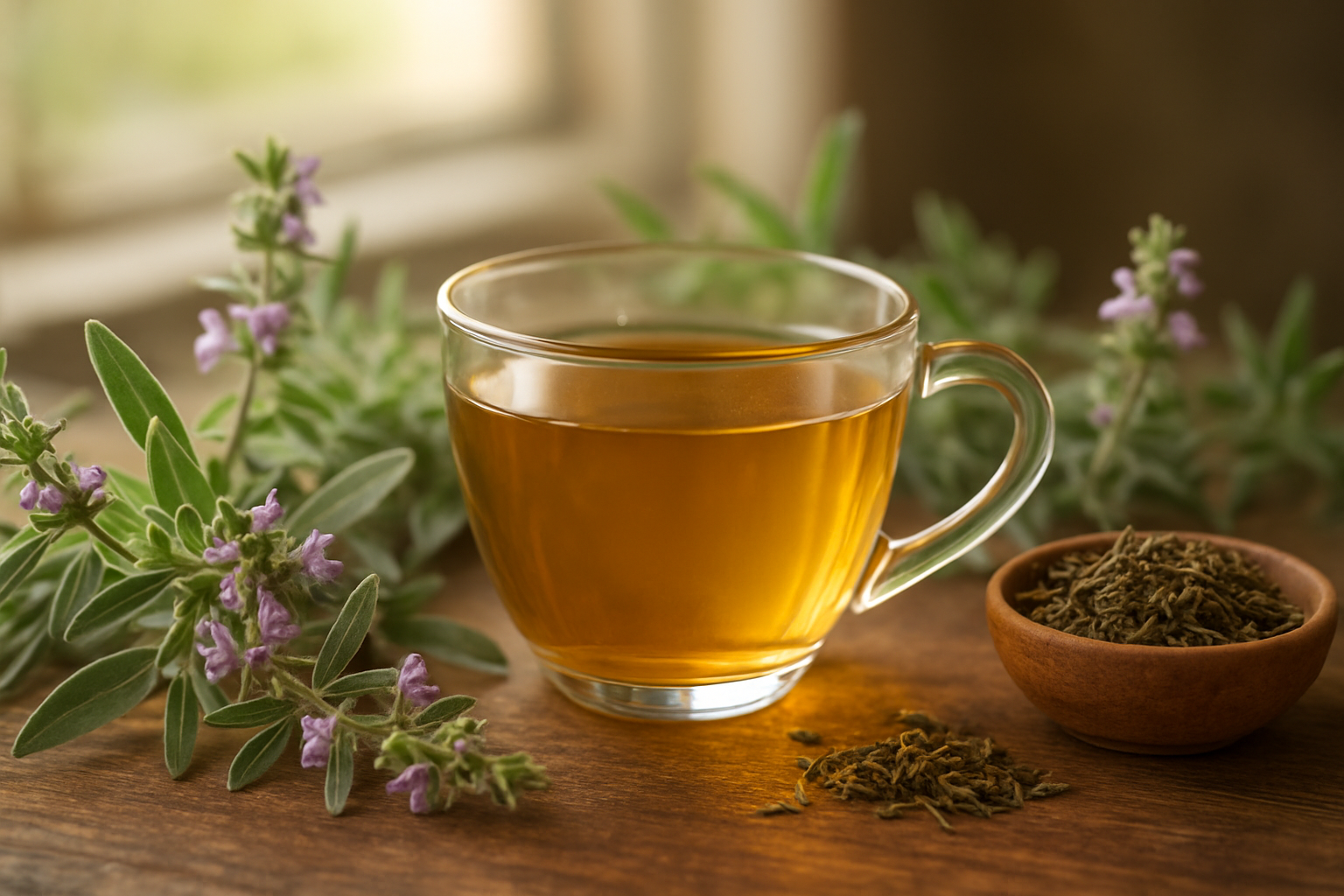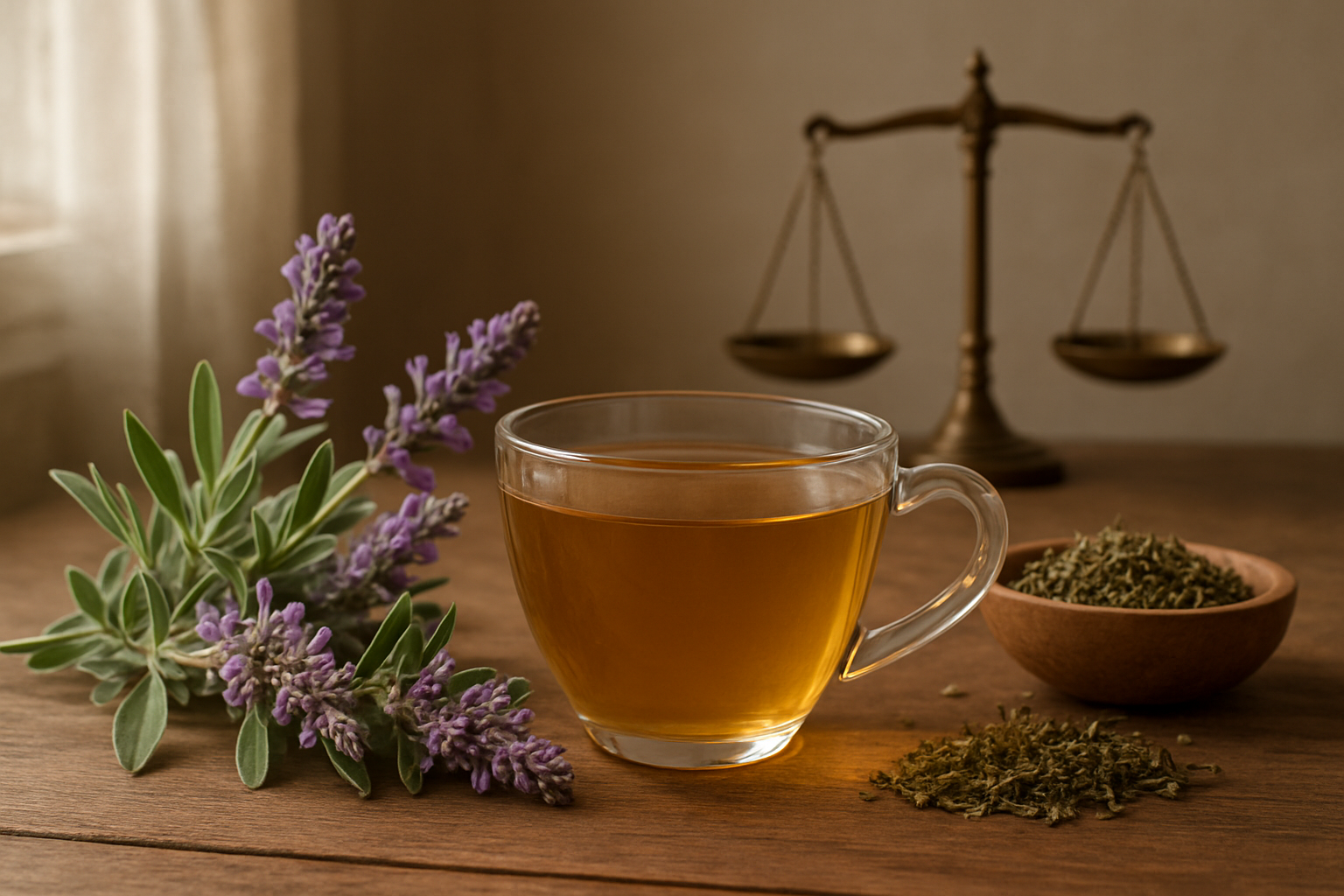Stachys lavandulifolia tea has caught the attention of herbal tea enthusiasts and health-conscious individuals looking for natural wellness solutions. This aromatic herbal brew, made from the leaves of a Mediterranean mint family plant, offers a unique blend of potential health benefits and important safety considerations.
This guide is perfect for herbal tea lovers, natural health seekers, and anyone curious about adding this lesser-known tea to their wellness routine. We’ll explore the science-backed health benefits that make this tea special, including its impressive effects on mental clarity and cognitive function. You’ll also learn about the potential risks and side effects you should know before brewing your first cup, plus practical guidelines for safe consumption that help you enjoy this herbal tea responsibly.
Understanding Stachys lavandulifolia Tea and Its Origins

Botanical characteristics and natural habitat
Stachys lavandulifolia, commonly known as lavender-leaved betony, belongs to the mint family (Lamiaceae) and thrives in the mountainous regions of the Middle East, particularly Iran, Turkey, and parts of the Mediterranean basin. This perennial herb features distinctive lance-shaped leaves covered in fine, silvery hairs that give them a woolly texture reminiscent of lavender foliage. The plant typically grows 12-18 inches tall and produces small purple or pink flowers arranged in dense spikes during summer months.
The herb’s natural habitat includes rocky slopes, dry meadows, and limestone-rich soils at elevations between 1,000-3,000 meters above sea level. These harsh growing conditions contribute to the plant’s robust concentration of bioactive compounds, including phenolic acids, flavonoids, and essential oils. The silvery leaves serve as protection against intense mountain sunlight and help the plant conserve moisture in arid environments.
Wild populations of Stachys lavandulifolia display remarkable adaptability to temperature fluctuations and drought conditions. The plant’s deep root system allows it to access underground water sources, while its aromatic compounds naturally repel herbivores and insects.
Traditional uses in folk medicine
Persian and Turkish traditional medicine systems have valued Stachys lavandulifolia for centuries, particularly for its calming and digestive properties. Rural communities in Iran’s Zagros Mountains have long brewed the dried leaves to treat anxiety, insomnia, and stomach ailments. Folk healers traditionally recommended the tea for women experiencing menstrual discomfort and for elderly individuals struggling with memory issues.
In Turkish folk medicine, the herb earned the nickname “mountain tranquilizer” due to its reputation for easing nervous tension and promoting restful sleep. Traditional practitioners often combined it with other local herbs like chamomile or mint to create personalized healing blends based on individual needs.
Shepherds and nomadic tribes historically carried dried Stachys lavandulifolia during long journeys, brewing the tea around campfires to combat fatigue and altitude sickness. The herb’s antimicrobial properties also made it valuable for treating minor wounds and skin irritations in remote areas where medical care was unavailable.
How the tea is prepared and consumed
Preparing Stachys lavandulifolia tea requires careful attention to preserve its delicate compounds and mild flavor profile. The most common method involves steeping 1-2 teaspoons of dried leaves in 8 ounces of hot water (not boiling) for 5-7 minutes. Water temperature should remain between 175-185°F to prevent destroying heat-sensitive antioxidants.
Fresh leaves can also be used when available, requiring slightly longer steeping times of 8-10 minutes. Many people prefer to cover the cup during steeping to trap volatile oils that contribute to the tea’s therapeutic effects. The resulting brew displays a pale golden color with a subtle, herbaceous aroma reminiscent of lavender and mint.
Traditional preparation methods often involve sun-drying the leaves for several days before storage in airtight containers. Some communities create tea blends by mixing Stachys lavandulifolia with honey, lemon, or complementary herbs. The tea tastes mildly bitter with earthy undertones, making it suitable for consumption without sweeteners, though honey pairs well with its natural flavor profile.
Proven Health Benefits of Stachys lavandulifolia Tea

Anti-inflammatory Properties for Joint and Muscle Health
Stachys lavandulifolia tea contains powerful anti-inflammatory compounds that can significantly benefit your joints and muscles. The plant’s natural bioactive substances work to reduce inflammation at the cellular level, making it particularly helpful for people dealing with arthritis, muscle soreness, or general joint stiffness.
Research shows that regular consumption of this herbal tea can help decrease inflammatory markers in the body. The anti-inflammatory action comes from several key compounds, including flavonoids and phenolic acids, which actively combat the inflammatory pathways that cause pain and swelling.
Many people find relief from chronic joint pain after incorporating this tea into their daily routine. The anti-inflammatory effects are gentle yet effective, providing a natural alternative to conventional pain medications for mild to moderate discomfort.
Digestive System Support and Stomach Soothing Effects
Your digestive system gets significant support from Stachys lavandulifolia tea’s soothing properties. This herbal remedy has been traditionally used to calm upset stomachs, reduce bloating, and ease digestive discomfort.
The tea works by relaxing the smooth muscles in your digestive tract, which helps reduce cramping and spasms. This makes it particularly beneficial for people with irritable bowel syndrome or those who frequently experience digestive stress.
Key digestive benefits include:
- Reducing stomach acid production naturally
- Calming intestinal inflammation
- Supporting healthy gut bacteria balance
- Easing nausea and morning sickness
- Promoting better nutrient absorption
The gentle nature of this tea makes it suitable for people with sensitive stomachs who can’t tolerate stronger herbal remedies. Regular consumption can help maintain digestive health and prevent common stomach issues from developing.
Respiratory Health Improvements and Congestion Relief
Stachys lavandulifolia tea offers remarkable benefits for your respiratory system, particularly when dealing with congestion, coughs, or breathing difficulties. The plant’s natural compounds act as mild bronchodilators, helping to open up airways and make breathing easier.
The tea’s expectorant properties help loosen mucus and phlegm, making it easier to clear your respiratory passages. This is especially helpful during cold and flu season or for people with chronic respiratory conditions like asthma or bronchitis.
Respiratory Benefits:
| Condition | How It Helps |
|---|---|
| Chest congestion | Loosens mucus for easier expulsion |
| Dry cough | Soothes irritated throat tissues |
| Allergic reactions | Reduces inflammation in airways |
| Seasonal allergies | Natural antihistamine effects |
The warming properties of the tea also provide immediate comfort when you’re feeling under the weather, while the steam from hot tea adds extra moisture to help clear nasal passages.
Antioxidant Compounds That Fight Cellular Damage
The antioxidant power of Stachys lavandulifolia tea is truly impressive. These natural compounds work tirelessly to protect your cells from damage caused by free radicals, which are unstable molecules that can lead to premature aging and various health problems.
The tea contains several types of antioxidants, including vitamin C, flavonoids, and polyphenols. These work together to neutralize harmful free radicals before they can damage your cells, DNA, and tissues.
Regular consumption of this antioxidant-rich tea can help:
- Slow down the aging process
- Boost immune system function
- Protect against chronic diseases
- Improve skin health and appearance
- Support cardiovascular health
- Enhance overall cellular repair processes
The concentration of antioxidants in Stachys lavandulifolia tea is comparable to green tea and other well-known antioxidant powerhouses. What makes this tea special is its unique combination of compounds that work synergistically to provide maximum protective benefits for your body’s cells and organs.
Mental and Cognitive Wellness Advantages

Natural stress reduction and anxiety relief
Stachys lavandulifolia tea contains compounds that naturally calm the nervous system, making it a powerful ally against daily stress and anxiety. The plant’s active components, including rosmarinic acid and flavonoids, work together to reduce cortisol levels and promote a sense of tranquility. Regular consumption can help your body better handle stressful situations by supporting the parasympathetic nervous system, which controls your body’s rest-and-digest response.
Studies have shown that people who drink this herbal tea experience measurable reductions in anxiety symptoms within 30-45 minutes of consumption. The bioactive compounds cross the blood-brain barrier and interact with GABA receptors, the same pathways targeted by anti-anxiety medications but through gentler, natural mechanisms. This makes it particularly valuable for those seeking stress relief without the side effects associated with pharmaceutical alternatives.
The tea’s adaptogenic properties help regulate your body’s stress response over time, building resilience against future anxiety triggers. Many users report feeling more emotionally balanced and less reactive to daily pressures after incorporating this tea into their routine.
Sleep quality enhancement and relaxation benefits
The sedative properties of Stachys lavandulifolia make it exceptionally effective for improving sleep quality and promoting deep relaxation. The herb contains natural compounds that encourage the production of melatonin while reducing the mental chatter that often keeps people awake at night.
Key sleep benefits include:
- Shorter time to fall asleep (reduced sleep latency)
- Deeper, more restorative sleep phases
- Fewer nighttime awakenings
- Improved morning alertness and energy levels
Unlike pharmaceutical sleep aids, this tea doesn’t cause dependency or morning grogginess. The relaxation effects begin within 20-30 minutes of consumption, making it perfect for evening wind-down routines. The warm ritual of preparing and sipping the tea also signals to your body that it’s time to transition from daytime activities to rest mode.
Regular evening consumption can help reset disrupted circadian rhythms, particularly beneficial for shift workers or those dealing with jet lag. The tea’s muscle-relaxing properties also ease physical tension that might interfere with comfortable sleep positioning.
Memory and concentration support
Stachys lavandulifolia contains neuroprotective compounds that support cognitive function and mental clarity. The antioxidants present in the tea help protect brain cells from oxidative stress, which can impair memory formation and recall abilities. Regular consumption may enhance both short-term working memory and long-term memory consolidation.
The tea’s ability to improve blood circulation extends to cerebral blood flow, ensuring your brain receives adequate oxygen and nutrients for optimal performance. This increased circulation can sharpen focus and reduce mental fog, making it easier to tackle complex tasks or maintain attention during lengthy projects.
Cognitive benefits observed in users:
| Benefit | Timeline | Duration |
|---|---|---|
| Improved focus | 45-60 minutes | 3-4 hours |
| Enhanced memory recall | 2-3 weeks regular use | Cumulative |
| Reduced mental fatigue | 30 minutes | 2-3 hours |
The herb’s anti-inflammatory properties may also protect against age-related cognitive decline by reducing neuroinflammation, a key factor in memory deterioration. Students and professionals often find that incorporating this tea into their daily routine helps maintain mental sharpness during demanding periods while supporting overall brain health for long-term cognitive wellness.
Potential Side Effects and Health Risks

Allergic Reactions and Sensitivity Concerns
People with existing plant allergies should exercise caution when trying Stachys lavandulifolia tea for the first time. The herb belongs to the mint family, which means those allergic to other mint-related plants like basil, oregano, or lavender might experience cross-reactivity. Common allergic symptoms include skin rashes, itching, hives, or respiratory issues like wheezing and difficulty breathing.
Some individuals develop contact dermatitis simply from handling the dried herb during preparation. If you notice any unusual skin reactions, swelling around the face or throat, or breathing difficulties after consuming the tea, discontinue use immediately and seek medical attention. Starting with a very small amount – perhaps half a cup of weak tea – can help identify potential sensitivities before consuming larger quantities.
Interactions with Prescription Medications
Stachys lavandulifolia contains bioactive compounds that may interfere with certain medications. The herb’s sedative properties can amplify the effects of sleep aids, anti-anxiety medications, and antidepressants, potentially causing excessive drowsiness or dangerous sedation levels.
Blood pressure medications require special attention since some studies suggest the herb may have hypotensive effects. Combining it with existing blood pressure drugs could lead to dangerously low blood pressure readings. Similarly, people taking anticoagulant medications should consult their healthcare provider, as herbal teas can sometimes affect blood clotting mechanisms.
Diabetes medications present another concern. The tea might influence blood sugar levels, requiring adjustments to insulin or oral diabetes drugs. Always inform your doctor about herbal tea consumption during medical consultations to avoid potentially harmful drug interactions.
Gastrointestinal Disturbances in Sensitive Individuals
While many people tolerate Stachys lavandulifolia tea well, some experience digestive upset, particularly when consuming strong concentrations or drinking it on an empty stomach. Common gastrointestinal side effects include nausea, stomach cramping, diarrhea, and acid reflux.
People with existing digestive conditions like irritable bowel syndrome, gastritis, or acid reflux disease may find their symptoms worsen after drinking the tea. The herb’s natural compounds can sometimes stimulate stomach acid production, leading to heartburn or indigestion in susceptible individuals.
Drinking the tea with food or reducing the steeping time can help minimize these effects. If digestive problems persist or worsen, stop consumption and consider consulting a healthcare professional about alternative herbal options that might be gentler on your system.
Effects During Pregnancy and Breastfeeding
Pregnant and breastfeeding women should avoid Stachys lavandulifolia tea due to insufficient safety research during these critical periods. The herb’s bioactive compounds could potentially cross the placental barrier or pass into breast milk, affecting fetal development or infant health in unknown ways.
The sedative properties that make this tea appealing for stress relief could pose risks during pregnancy, potentially affecting maternal blood pressure or interfering with normal pregnancy processes. Some herbal compounds can trigger uterine contractions or hormonal changes that might complicate pregnancy outcomes.
Nursing mothers face additional concerns since infants’ developing systems are particularly sensitive to foreign compounds. Even small amounts of herbal constituents in breast milk could cause unexpected reactions in babies, including excessive sleepiness, feeding difficulties, or digestive upset. Healthcare providers typically recommend avoiding unstudied herbal preparations during pregnancy and breastfeeding to protect both mother and child from potential adverse effects.
Safe Consumption Guidelines and Precautions

Recommended dosage and brewing instructions
Getting the right amount of Stachys lavandulifolia tea makes all the difference between enjoying its benefits and experiencing unwanted effects. Most herbalists recommend starting with 1-2 teaspoons of dried leaves per 8 ounces of water. New users should begin with half this amount to gauge their body’s response.
For brewing, water temperature matters more than you might think. Heat water to just below boiling (around 195-205°F) and pour over the dried leaves. Steep for 5-8 minutes for optimal extraction without making the tea overly bitter. Some people prefer a longer steeping time of up to 10 minutes for stronger therapeutic effects, but this can increase the concentration of active compounds.
Daily consumption should stay within reasonable limits. Most practitioners suggest 1-2 cups per day, with breaks between usage periods. Taking the tea for 5 days followed by a 2-day break helps prevent your body from building tolerance while maintaining effectiveness.
Timing your tea consumption can enhance its benefits. Morning consumption may provide better cognitive support throughout the day, while evening use might promote relaxation. Avoid drinking it too close to bedtime if you’re sensitive to its active compounds.
When to consult healthcare professionals
Several situations require professional medical guidance before starting Stachys lavandulifolia tea. Anyone taking prescription medications should speak with their doctor first, as herbal teas can interact with various drugs including blood thinners, diabetes medications, and sedatives.
Pregnant and breastfeeding women need medical clearance before using any herbal preparations. The safety profile during pregnancy hasn’t been thoroughly established, making professional oversight essential. Similarly, parents considering this tea for children under 12 should get pediatric approval first.
People with chronic health conditions deserve extra caution. Those managing diabetes, heart disease, liver problems, or autoimmune disorders should discuss potential interactions with their healthcare team. The tea’s bioactive compounds might affect blood sugar levels or interfere with existing treatments.
Watch for warning signs that signal immediate medical attention: unusual allergic reactions, severe digestive upset lasting more than 24 hours, or any unexpected symptoms after starting the tea. Stop consumption and contact your healthcare provider if you experience persistent headaches, dizziness, or changes in heart rhythm.
Mental health medication users need special consideration, as some compounds in the tea might interact with antidepressants or anti-anxiety medications.
Quality sourcing and preparation standards
Finding high-quality Stachys lavandulifolia requires careful attention to your supplier’s practices. Reputable vendors provide detailed information about their sourcing locations, harvesting methods, and processing techniques. Look for suppliers who can trace their products back to specific growing regions and harvest dates.
Organic certification offers valuable assurance about pesticide-free cultivation, though not all quality producers pursue formal certification due to costs. Ask potential suppliers about their growing practices, soil testing, and contamination prevention measures.
Proper storage protects your investment and maintains potency. Store dried leaves in airtight containers away from direct sunlight, heat, and moisture. Glass jars or sealed metal tins work better than plastic bags for long-term storage. Properly stored tea maintains its quality for 12-18 months.
Visual inspection reveals quality clues. High-grade dried leaves should maintain some color rather than appearing uniformly brown or gray. The aroma should be pleasant and distinctly herbal without musty or off-putting odors that might indicate mold or improper drying.
Third-party testing adds another layer of quality assurance. Some premium suppliers provide certificates of analysis showing tests for heavy metals, pesticide residues, and microbial contamination. While not always available, these reports demonstrate a supplier’s commitment to safety standards.
Prepare your brewing equipment properly by cleaning teapots and cups thoroughly. Use filtered water when possible, as chlorine and other chemicals in tap water can interfere with the tea’s natural flavors and potentially its therapeutic compounds.

Stachys lavandulifolia tea offers a compelling mix of proven health benefits, from supporting mental clarity and cognitive function to providing various wellness advantages. Like any herbal remedy, this traditional tea comes with its own set of considerations – understanding both the positive effects and potential risks helps you make smart choices about adding it to your routine.
Before you start brewing this aromatic tea regularly, take time to research proper dosages and talk with your healthcare provider, especially if you’re taking medications or have existing health conditions. The key to getting the most from Stachys lavandulifolia tea lies in informed, moderate use – respecting both its therapeutic potential and the importance of safe consumption practices.














